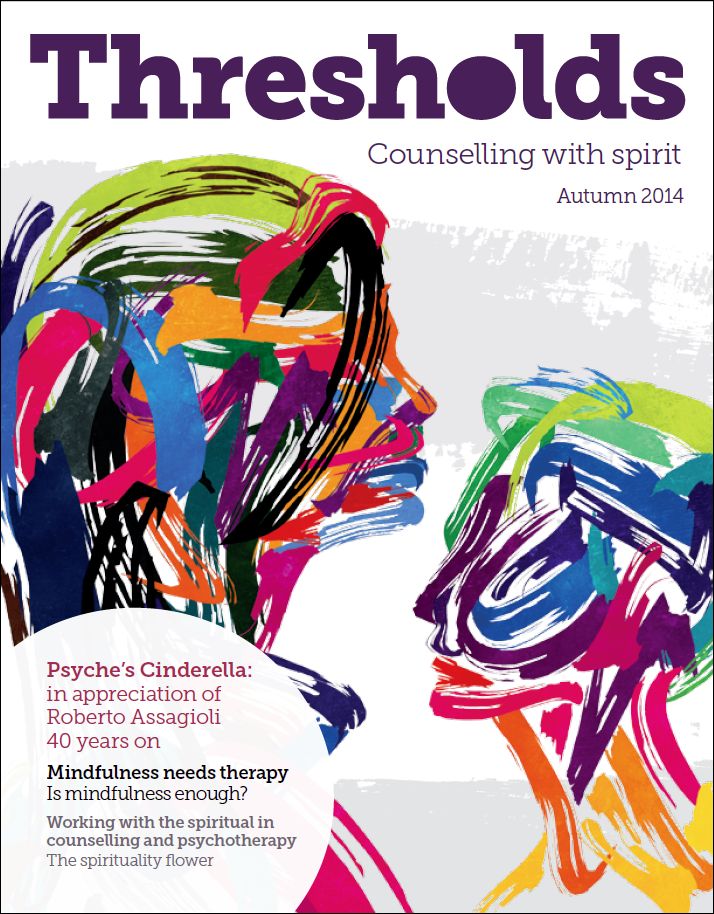In this issue
Features
Special focus
Psyche’s Cinderella: in appreciation of Roberto Assagioli (free article)
Keith Hackwood looks at the life and work of the founder of psychosynthesis
People
Mindfulness needs therapy
Alistair Appleton questions certain aspects of mindfulness and emphasises the importance of therapy
Practice
Working with the spiritual in counselling and psychotherapy
Valda Swinton and Colin Jay show how the spirituality flower can be a useful tool
Perspectives
Intuitive consciousness: our deepest source of wisdom as a pathway to change
Sara Hollwey and Jill Brierley describe their approach to personal power in therapy
Perspectives
Three levels of empathy
John Rowan approaches empathy from several viewpoints
Opinion
Supervision and pastoral care
John Foskett responds to the recent rebranding of the division
Regulars
From the chair
Melody Cranbourne-Rosser: Creative tension

All of the articles from this issue are not yet available online. Divisional members and subscribers can download the pdf from the Thresholds archive.
Welcome from the editor
What is it that determines the outcome of a psychotherapeutic encounter? Is it the school of psychotherapy that the therapist is trained in? Is it the length and frequency of therapy? Which factors can be influenced by the therapist? What is it that contributes to someone becoming/being a good listener? Can the relevant skills be taught and, if so, how?
From the point of view of a client, what is it about a therapist that makes the client wish to work with them? For me, it is vitally important that I sense that the therapist is present. The quality of their presence is crucial to the process and the intimacy of relationship that can be formed in the encounter. It is possible that the awareness a therapist has plays a crucial role in the outcome of a psychotherapeutic encounter.
I used to go to an Alexander Technique teacher in Helsinki who once encouraged me, while standing at a window, to ‘allow the view to come to you’. This approach led to a more receptive field of awareness, allowing, accepting, welcoming what is there, rather than a striving to capture things and hold on to them. On a weekend retreat in 2012 with Alistair Appleton at the Abbey, Sutton Courtenay, I explored allowing whatever ‘is’ to just ‘be’ in my field of vision (the most ironic example within half an hour being a red kite (bird of prey) and later a military helicopter). I found it quite exhilarating to play with the approach taught to me by an Alexander Technique teacher and to widen the approach by applying it to thoughts and emotions, not just visual objects.
But, perhaps it is not enough to be mindful? I feel more is required in psychotherapy (although a deep understanding of mindfulness may incorporate ‘everything’). A client may not be aware of their own shortcomings, nor of their own goodness. Robert Masters in his challenging book, Spiritual bypassing, calls for an ‘emotionally literate, somatically attuned, spiritually vital psychotherapy’1. Masters’ expression, ‘spiritually vital’, intrigues me. I think my conception of ‘mindfulness’ can be rather limited and sometimes I long for more playful modes of transformation. An important aspect of the foundational teaching of mindfulness in Buddhism (found in the Satipat.t.ha-na sutta and explored by the Buddhist scholar, Ana-layo) is the instruction to practise both internally and externally2. External practice means to carefully observe the outer manifestations of another person’s feelings and states of mind (which could be shown in their facial expressions, tone of voice and body language). Ana-layo warns that: ‘One can become excessively concerned with what happens with and within oneself while at the same time remaining unaware of how one’s action and behaviour affect others. Practising both internal and external [mindfulness] can prevent such lop-sidedness and achieve a skilful balance between introversion and extroversion1. In this issue, Alistair Appleton reflects on his experience of training to be a psychotherapist and his experience of teaching mindfulness. Mindfulness has become extremely popular and can be regarded as a panacea. Sometimes, in my view, people turn to Buddhist practices to avoid the more challenging aspects of life, seeing it as an escape from life. Going on retreat can seem very appealing; more appealing than grappling with difficulty in a relationship. It can be a form of spiritual bypassing. Alistair Appleton calls for an approach that allows us to address the dissociation, so prevalent in our society.
Marking anniversaries and celebrating the life of an important figure in ‘our lineage’ is very important. In this autumn issue of Thresholds, Keith Hackwood marks the 40th anniversary of Roberto Assagioli’s death with a fascinating description of his life and work. Assagioli’s psychosynthesis is a form of therapy that addresses the emotional, the somatic and the spiritual. Tools such as the Spirituality Flower, described by Valda Swinton and Colin Jay, offer a creative way to open a discussion on the spiritual aspects of clients’ lives. My own experience of being a client includes my delight when being able to bring my own spirituality to the therapeutic encounter.
John Rowan’s exploration of empathy widens the usual definitions. Empathy is regarded as a vital skill for a therapist, but is our understanding of empathy limited? Sara Hollwey and Jill Brierley’s article is an inspiring exploration of how clients can be encouraged to work with different aspects of their personal power. How can a client work with issues of personal power in therapy?
As I write this editorial, in mid September, I am preparing myself for the beginning of a new academic year. As a student, about to embark on my third year of psychotherapy training, I am so grateful to the contributors to Thresholds, who enthusiastically share their experience and knowledge. I would like to encourage readers to consider writing articles and look forward to hearing from you and continuing lively discussions.
Amanda Anderson
Editor
thresholds.editorial@bacp.co.uk
References
1. Masters RA. Spiritual bypassing: when spirituality disconnects us from what really matters. Berkeley: North Atlantic Books; 2010.
2. Ana-layo. Satipat.t.ha - na: the direct path to realization. Cambridge: Windhorse publications; 2003.
